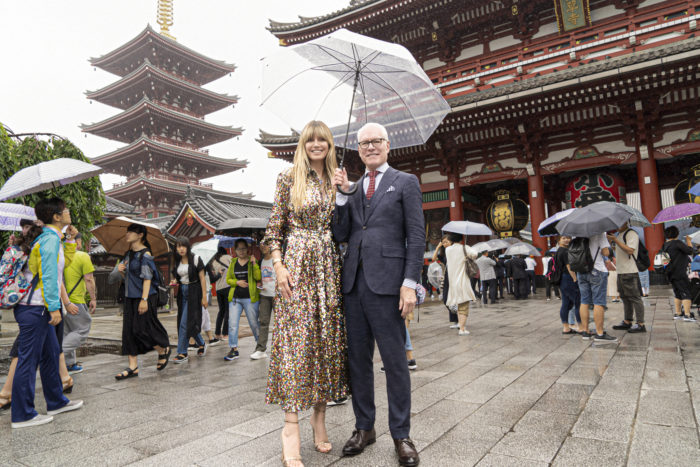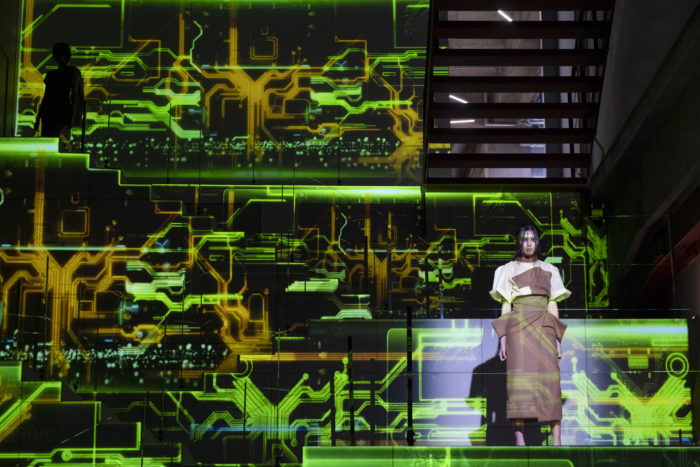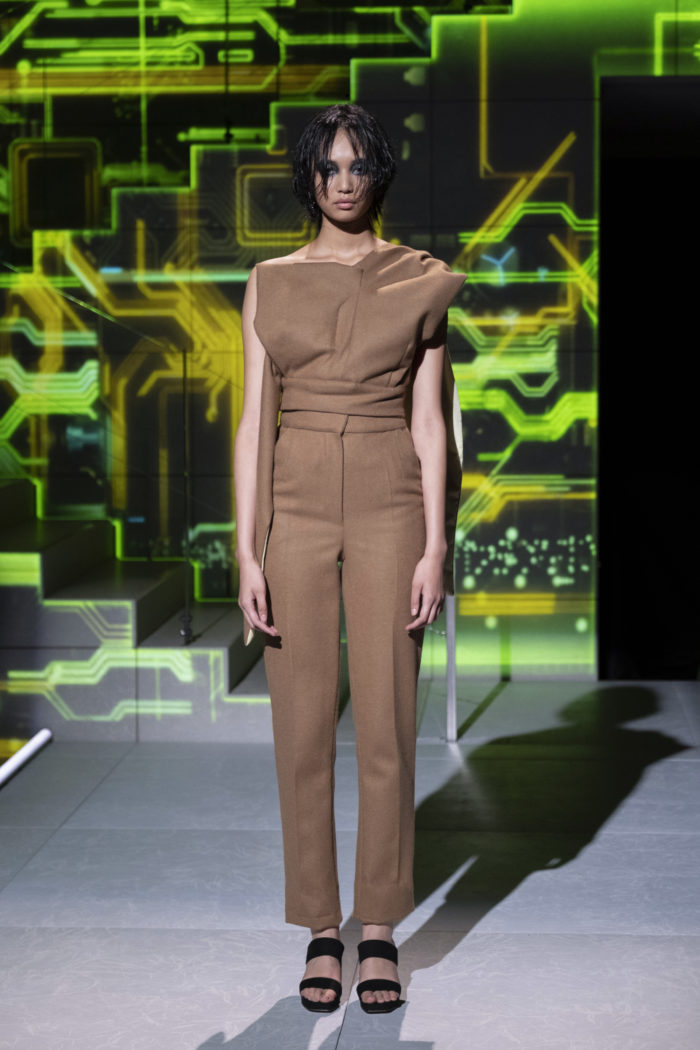
It’s time for another episode of Making the Cut in gorgeous Tokyo. “Opposing Forces” began with stormy skies as the six remaining designers gathered to greet judge Heidi Klum and mentor Tim Gunn.

The “Opposing Forces” challenge
Heidi and Tim presented the challenge at Sensoji, the oldest Buddhist temple in Tokyo. Tim pointed out that Tokyo is a dichotomy of old and new, and so the designers were instructed to focus on the yin and yang. After identifying two opposing forces, they needed to create a two-look collection, offering one runway-ready look and one marketable ensemble. The fashion showcase was an “immersive digital showcase” with themed settings projected on the wall of the Amazon fashion studio where the runway show was planned.
Esther Perbandt, notorious for using only black fabrics in her designs, chose to add gold and neon yellow to her palette.
Sander Bos seemed resentful of the judges’ insistence that he design something accessible. He refused to sketch anything complex, focusing instead on T-shirts.
Rinat Brodach said a traditional Shabbat prayer with Sander and Jonny Cota to mark the Jewish Sabbath and ask for blessings. The short yet touching moment among the designers reminded me that they still do some normal things around the events of the show.
The judging
In this episode, the judges were accompanied by virtual character Noonoouri, a digital avatar with a social media following of more than 300,000. She will “wear” the winner’s garment on her social media channels. It was unsettling for me to see a digital judge with anime-style features added to the show, as if she were in the real world.
Jonny Cota
The judges called up Jonny first. His collection was a contrast of light and dark. His palette was dark, but he said darkness can’t be appreciated without light. The judges liked his two looks, commenting that he had softened his hard aesthetic. His looks had a rock-and-roll feel but were accessible. Jonny made the cut.
Esther Perbandt
Next up was Esther. Her opposing forces concept was light and shadow. Black was still the center of her aesthetic, but she introduced color and metallic tones. The judges appreciated that she tried something new. However, they zeroed in on the unflattering combination of PVC material and metallics, calling it costume-y. In the end, however, she made the cut. (For information on choosing, caring for, and sewing metallic fabrics, see “Fabric Lab: Precious metallics” in Threads #194, Dec. 2017/Jan. 2018.)
Sander Bos
Sander focused on the duality of consumerism and art by transforming T-shirt silhouettes and ordinary trouser styles into chic, innovative ensembles. The judges said they liked that his two looks were cohesive. Naomi said she wanted to wear them and wanted to see more looks like these. They called this collection on-brand for him. Sander was the winner of this challenge.


Ji Won Choi
Ji Won Choi’s collection examined the intersection of her Korean heritage and the modern Western world. Naomi said she loved Ji’s Korean look. She and the other judges weren’t impressed with the second look, though. They criticized her for being too one-note with her design silhouettes. She made the cut.
Rinat Brodach
Finally, Rinat spoke about her collection. She juxtaposed Hasidic Judaism and Buddhism. The judges returned to their refrain for Rinat, telling they didn’t see her voice, especially since they’ve gotten to know her competitors’ voices better throughout the show. Heidi said the looks were unflattering. Rinat did not make the cut. Naomi fought to keep her, but ultimately, the majority ruled.
Interview with the “Opposing Forces” winner
The publicity team for the show has given me access to the winning designer from each episode, for a short interview.
Sander was my first repeat interview, and it was fun to catch up. I asked how the second win felt. “It was a little bit of a crazy win, I didn’t really expect it,” he said. “I kind of went into the challenge like ‘I’m gonna do this, I’m gonna put my foot down, and I’m gonna go home, or they’re gonna love it.’ I knew I wasn’t going to be safe this episode.”
Choosing the showcase backdrop
How did Sander settle on the circuit board theme for the immersive showcase? “The only thing that I was like, ‘OK, I can work with this’ was the chip card, that I thought I could kind of link in with . . . the concept of the T-shirt. Fast fashion lives mostly on the internet,” he said, then laughed. “My enemy, consumerism.”
During the episode, he seemed resentful or frustrated with the judges’ criticism of the level of accessibility in his work. “I felt like the whole competition I was trying my very, very best to make it as successful as possible within my own range of work, you know, you don’t want to lose yourself,” he said.
Create a look that sells
It’s understandable that he did not want to lose himself, but I wondered how he was going to support a brand in the long run if he wasn’t concerned with selling garments. He seemed almost contemptuous of the T-shirt and what it stood for in his mind, which surprised me seeing as he won based on a T-shirt-inspired look.
“To me, the T-shirt is this forever-standing icon over time and also of fast fashion,” he said. “You know, fashion has changed a lot in the last 50, 60 years and I cannot imagine a T-shirt walking down the runway of, you know, like old-school Balenciaga or Dior . . . It’s kind of almost like the hamburger, you know? It’s there really to be consumed, and not really to be taken as an art form or be taken as anything more than a product that you just slap on your body and hope you make it through the day.”
Did he think his consumerism versus art theme was going to come together at the end. “I can’t tell you that I did, but I can’t tell you that I didn’t,” he said sheepishly. “I was kind of like so focused on ‘I have to make the point’ that I was kind of losing sight that there was going to be an elimination and a winner.”
Dress the virtual judge
What was Sander’s reaction to virtual judge Noonoouri—who I had not heard of before the episode? She was unknown to him, too. “I didn’t know that she was virtual, so when they told me that I won and ‘Congratulations, Noonoouri was in the public and she liked your [look] very much and she’s going to wear it.’ Of course, idiot that I am . . . I’m like, ‘Oh, what size is she so I can make it for her?’ and everybody starts laughing, even the production was laughing,” he said.
Finally, I asked him about the newly accessible version of his aesthetic and whether he thought it was something he would continue with after the show. “I think it’s definitely something that I’ve pushed forward in my brand since the show,” he said. “I think I really learned that it’s also OK for me to do something more commercial . . . I don’t feel that I’m losing my art form, that I’m betraying it, you know, or mocking it.”
































Log in or create an account to post a comment.
Sign up Log in